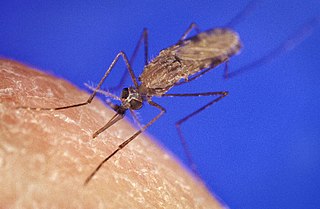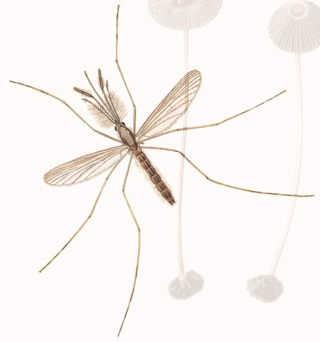
Malaria is a mosquito-borne infectious disease that affects vertebrates. Human malaria causes symptoms that typically include fever, fatigue, vomiting, and headaches. In severe cases, it can cause jaundice, seizures, coma, or death. Symptoms usually begin 10 to 15 days after being bitten by an infected Anopheles mosquito. If not properly treated, people may have recurrences of the disease months later. In those who have recently survived an infection, reinfection usually causes milder symptoms. This partial resistance disappears over months to years if the person has no continuing exposure to malaria.

Plasmodium is a genus of unicellular eukaryotes that are obligate parasites of vertebrates and insects. The life cycles of Plasmodium species involve development in a blood-feeding insect host which then injects parasites into a vertebrate host during a blood meal. Parasites grow within a vertebrate body tissue before entering the bloodstream to infect red blood cells. The ensuing destruction of host red blood cells can result in malaria. During this infection, some parasites are picked up by a blood-feeding insect, continuing the life cycle.

Anopheles is a genus of mosquito first described by J. W. Meigen in 1818, and are known as nail mosquitoes and marsh mosquitoes. Many such mosquitoes are vectors of the parasite Plasmodium, a genus of protozoans that cause malaria in birds, reptiles, and mammals, including humans. The Anopheles gambiae mosquito is the best-known species of marsh mosquito that transmits the Plasmodium falciparum, which is a malarial parasite deadly to human beings; no other mosquito genus is a vector of human malaria.

Plasmodium falciparum is a unicellular protozoan parasite of humans, and the deadliest species of Plasmodium that causes malaria in humans. The parasite is transmitted through the bite of a female Anopheles mosquito and causes the disease's most dangerous form, falciparum malaria. It is responsible for around 50% of all malaria cases. P. falciparum is therefore regarded as the deadliest parasite in humans. It is also associated with the development of blood cancer and is classified as a Group 2A (probable) carcinogen.

Plasmodium knowlesi is a parasite that causes malaria in humans and other primates. It is found throughout Southeast Asia, and is the most common cause of human malaria in Malaysia. Like other Plasmodium species, P. knowlesi has a life cycle that requires infection of both a mosquito and a warm-blooded host. While the natural warm-blooded hosts of P. knowlesi are likely various Old World monkeys, humans can be infected by P. knowlesi if they are fed upon by infected mosquitoes. P. knowlesi is a eukaryote in the phylum Apicomplexa, genus Plasmodium, and subgenus Plasmodium. It is most closely related to the human parasite Plasmodium vivax as well as other Plasmodium species that infect non-human primates.

The Anopheles gambiae complex consists of at least seven morphologically indistinguishable species of mosquitoes in the genus Anopheles. The complex was recognised in the 1960s and includes the most important vectors of malaria in sub-Saharan Africa, particularly of the most dangerous malaria parasite, Plasmodium falciparum. It is one of the most efficient malaria vectors known. The An. gambiae mosquito additionally transmits Wuchereria bancrofti which causes lymphatic filariasis, a symptom of which is elephantiasis.

Mosquito-borne diseases or mosquito-borne illnesses are diseases caused by bacteria, viruses or parasites transmitted by mosquitoes. Nearly 700 million people contract mosquito-borne illnesses each year, resulting in more than a million deaths.
Anopheles (Cellia) subpictus is a species complex of four species of mosquito belonging to the genus Anopheles.

Anopheles albimanus is a species of mosquito in the order Diptera. It is found in coastal Central and South America, the Caribbean, and Mexico. It is a generalist species and capable of wide dispersion. A. albimanus is a common malaria vector.

Anopheles stephensi is a primary mosquito vector of malaria in urban India and is included in the same subgenus as Anopheles gambiae, the primary malaria vector in Africa. A. gambiae consists of a complex of morphologically identical species of mosquitoes, along with all other major malaria vectors; however, A. stephensi has not yet been included in any of these complexes. Nevertheless, two races of A. stephensi exist based on differences in egg dimensions and the number of ridges on the eggs; A. s. stephensisensu stricto, the type form, is a competent malaria vector that takes place in urban areas, and A. s. mysorensis, the variety form, exists in rural areas and exhibits considerable zoophilic behaviour, making it a poor malaria vector. However, A. s. mysorensis is a detrimental vector in Iran. An intermediate form also exists in rural communities and peri-urban areas, though its vector status is unknown. About 12% of malaria cases in India are due to A. stephensi.
Plasmodium coatneyi is a parasitic species that is an agent of malaria in nonhuman primates. P. coatneyi occurs in Southeast Asia. The natural host of this species is the rhesus macaque and crab-eating macaque, but there has been no evidence that zoonosis of P. coatneyi can occur through its vector, the female Anopheles mosquito.

Anopheles claviger is a mosquito species found in Palearctic realm covering Europe, North Africa, northern Arabian Peninsula, and northern Asia. It is responsible for transmitting malaria in some of these regions. The mosquito is made up of a species complex consisting of An. claviger sensu stricto and An. petragnani Del Vecchio. An. petragnani is found only in western Mediterranean region, and is reported to bite only animals; hence, it is not involved in human malaria.
Anopheles nili is a species of mosquito in the Culicidae family. It comprises the following elements: An. carnevalei, An. nili, An. ovengensis and An. somalicus. The scientific name of this species was first published in 1904 by Theobald. It is the main mosquito species found in the south Cameroon forest zone which bites humans. It is known as a problematic carrier of malaria, although newly discovered, closely related species in the same genus have also been found to interact with A. nili as a disease vector. In that, they both have similar feeding habits on local targets in the Cameroon region.

Anopheles annularis is a species of mosquito belonging to the genus Anopheles. Larvae found in clean, lotic bodies of water with abundant vegetation. Females are zoophilic, mainly feed blood on cattle and humans. The species is a major malaria vector in India, Nepal and Sri Lanka. It is also an important vector for Plasmodium vivax in Afghanistan.

Anopheles barbirostris is a species complex of mosquito belonging to the genus Anopheles. Larvae found in clean, lotic bodies of water. Females are zoophilic, mainly feed blood on cattle and humans. It is also an important vector for Plasmodium falciparum in Sri Lanka and Timor, for both Plasmodium vivax and P. falciparum in Bangladesh.
Anopheles barbumbrosus is a species complex of mosquito belonging to the genus Anopheles. It has 12-36 thin attenuated branches usually loose and separated out, which is a good indication to separate it from A. barbirostris. It shows a marked zoophilic tendency, thus is a malaria vector, but with minor importance to humans. It is distributed throughout Peninsular Malaysia, Sumatra, Java, Thailand, India and Sri Lanka, They mostly live as an outdoor mosquito species, rarely found indoor places. Larva can be found in a variety of habitats including both partially shaded and sunlit fresh and slowly running water, grass-fringed streams to stagnant water pools and man-made places like rice fields.
Anopheles (Cellia) karwari is a species complex of zoophilic mosquito belonging to the genus Anopheles. It is found in India, and Sri Lanka, Bangladesh, Sumatra, and Java. A. karwari is a member of the Maculatus Group and the second scarcest species reported from Indonesia. Female is blood sucking and involved in transmitting Plasmodium falciparum, thus an important malarial vector. It is considered a secondary vector in the Australian region, but its vectorial status in South-East Asia was unknown.
Anopheles (Anopheles) nigerrimus is a species complex of zoophilic mosquito belonging to the genus Anopheles. It belongs to the Nigerrimus Subgroup and Hyrcanus Group of the Myzorhynchus Series. It is found in India, and Sri Lanka, Bangladesh, Brunei, Cambodia, China, Malaysia, Myanmar, Nepal, Pakistan, Thailand, and Vietnam. It is a Possible malaria and filariasis vector. It is found from ecosystems nearby water courses such as rice fields, canals, large open marshes, and also in partially sunny, shady deep pools with floating vegetation. In Sri Lanka, the adult and larval stages are known to show resistant to a range of organophosphate and carbamate insecticides. Cytologically, two karyotypic forms of A. nigerrimus are identified, as Form A and B.
Anopheles (Cellia) vagus is a species complex of zoophilic mosquito belonging to the genus Anopheles. It is found in India, Sri Lanka and Indonesia. It is a potential natural vector of malarial parasite Plasmodium falciparum, and Japanese encephalitis virus. It is highly susceptible to insecticide deltamethrin and resistant to DDT.
Anopheles (Cellia) varuna is a species complex of zoophilic mosquito belonging to the genus Anopheles. It is found in India, Sri Lanka Thailand and Vietnam. It is a secondary malaria vector in Sri Lanka. Larvae are known to feed on detritus, rod and cocci bacteria, diatom, filamentous algae and desmids. A microsporidium Thelohania obscura was discovered from the larvae in India in 1966.










